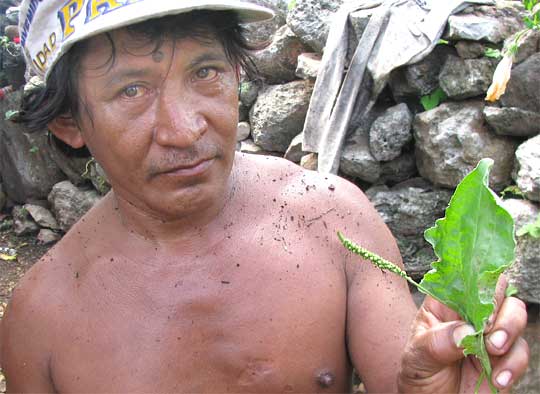Excerpts from Jim Conrad's
Naturalist Newsletter
from the September 8, 2008 Newsletter written in Sabacché and issued from a ciber in nearby Mérida, Yucatán, MÉXICO
DON VICENTE'S LLANTÉM
Don Vicente thinks it's hilarious that I'm interested in medicinal plants. Each time we meet he puts down what he's doing, looks around for something medicinal, and tells me about. This week I met him in front of his house as he came in from a morning of firewood gathering, his sweaty, muscular shoulders still covered with chaff and bits of wood from the scrub. He motioned for me to follow him behind his house, to a perpetually shaded, moist, narrow little dead-end alley where he plucked the sprig he's showing below:

"Llantém (yahn-TEM)," he named the plant. "If you have a child with an upset stomach you boil this plant's leaves to make a tea and the tea will cure it."
Of course any northerner will recognize the plant as Common Plantain, PLANTAGO MAJOR, a common lawn and roadside weed throughout much of North America and Europe. In fact, the plant is regarded as native to Europe. I thought it would be too hot and dry here for Common Plantain, but Don Vicente's perpetually shaded, sheltered little alley that receives drainage water from the house obviously provides a habitat that for the plantain is close enough to chilly Europe.
So, Common Plantain appears to be yet another Old World plant that somehow has made its way into the traditional Maya pharmacopia. Even Martinez's Las Plantas Medicinales de Mexico recognizes it as a traditional remedy, further recommending it for burns, bruises and mouth ulcers. Also, plantain tea mixed with rosewater is good for washing enflamed eyes.
But, is Common Plantain really a European invasive in the Americas? Weakley in the Flora of the Carolinas says that the species is possibly also native in northeastern North America, plus he mentions a population in Virginia's Chesapeake Bay area that "may represent a native, estuarine genotype." Could Common Plantain have already been here when the Europeans arrived? Could that explain why the plant is so well known to the Maya?
In much of Mexico Don Vicente's Llantém is known as Llantén. Yucatec Maya speakers habitually change n sounds at the end of words to m sounds. If a Maya returns from working in Houston, he's been to "OOST- um." In most of Mexico the plant's prevailing common name is Lantén, which is awfully close to Lanten, or Lantana. Well, these common names will drive you crazy. Thank goodness for the Latin Plantago major, which is a good ol' Linnaeus name.